China Youth & Education
Girls’ Charity Project Funds Boys Instead: Online Anger over ‘Spring Buds Program’
The ‘Spring Buds’ charity supposedly only focused on helping girls, but it turns out this is not the case.
Published
5 years agoon
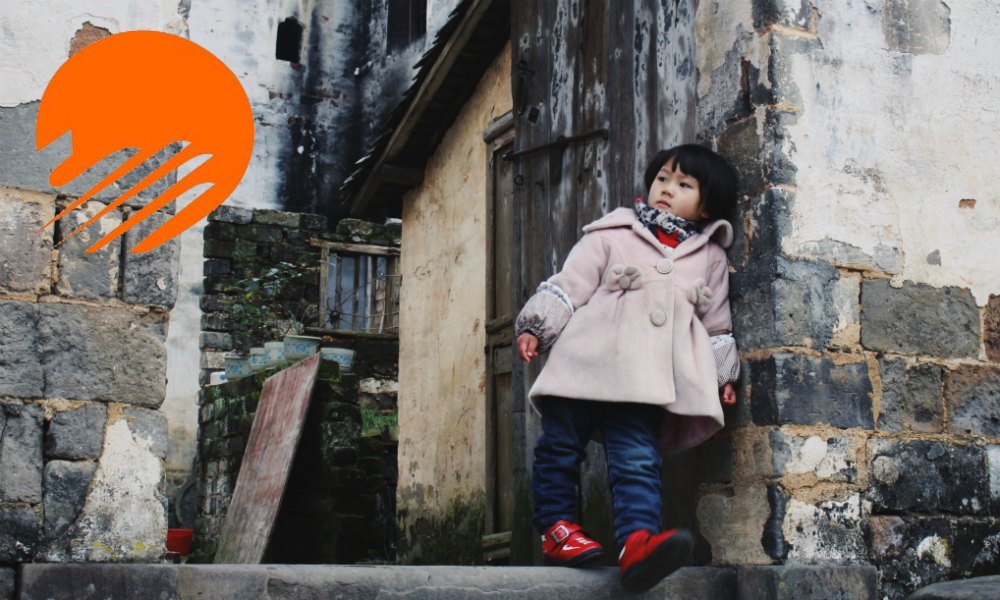
First published
A charity fund that was supposedly dedicated to girls’ education in rural China has been found to fund the education of boys, triggering anger online.
The Chinese charity “Spring Buds Program” (春蕾计划), a project meant to advance girls’ education launched by the CCTF (China Children and Teenagers’ Fund 中国儿童少年基金) has come under fire for providing financial aid to schoolboys in China.
The “Spring Buds” project, which falls under the All-China Women’s Federation, has received the China Charity Award in the past for its efforts to promote girls’ education. The program was launched in 1989 to help girls in China’s impoverished rural areas to go to school, improve literacy rates among China’s young girls and women, and empower girls to strengthen their influence in their local communities.
This week, the charity’s focus has come under scrutiny after it became known that of the 1267 students receiving financial aid as part of one of ‘Spring Buds’ scholarship programs, there were 453 male students.
The topic triggered wider online discussions on Chinese social media on gender inequality in China.
Some commenters argued that boys, even in impoverished areas, are generally still better off than girls due to a persisting gender preference for boy children.
Weibo users also pointed out how there are multiple non-gender specific charity programs in China, and that ‘Spring Buds’ is one of the few focused on girls only – arguing that it should thus also really be assisting solely girls.
As the news about ‘Spring Buds’ coincided with this week’s launch of the Global Gender Gap Index report, some Weibo users also wondered why Chinese official media would quote this report and mention Japan’s worsening gender equality, while not mentioning anything about the status quo of gender equality in China.
The CCTF responded to the controversy via their official Weibo account on December 17th, stating that although its program was initially focused solely on girls, this year’s project funding was also allocated to impoverished male students who needed “urgent help.”
The organization further noted that they will be more transparent to charity donors in the future about how their funds are allocated.
Although the hashtag “Anger over Spring Bud Project Subsidizing School Boys” (#春蕾计划资助男生引质疑#) was used on social media by several Chinese media outlets to report the issue, the hashtag page is no longer accessible on Weibo at time of writing.
By Manya Koetse and Miranda Barnes
Follow @whatsonweibo
Featured image photo by Ray Chan.
Spotted a mistake or want to add something? Please let us know in comments below or email us. First-time commenters, please be patient – we will have to manually approve your comment before it appears.
©2019 Whatsonweibo. All rights reserved. Do not reproduce our content without permission – you can contact us at info@whatsonweibo.com.
Stories that are authored by the What's on Weibo Team are the stories that multiple authors contributed to. Please check the names at the end of the articles to see who the authors are.

China Media
12-Year-Old Girl from Shandong Gets Infected with HPV: Viral Case Exposes Failures in Protecting Minors
A doctor in Tai’an faced resistance when she tried to report a 12-year-old girl’s HPV case. She then turned to social media instead.
Published
3 months agoon
December 18, 2024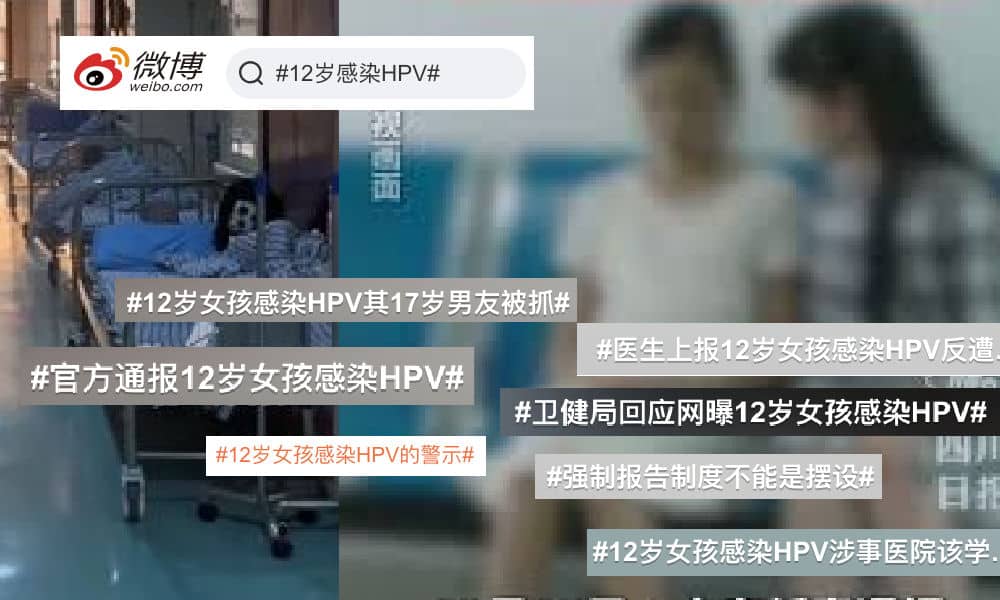
A 12-year-old girl from Shandong was diagnosed with HPV at a local hospital. When a doctor attempted to report the case, she faced resistance. Weibo users are now criticizing how the incident was handled.
Over the past week, there has been significant uproar on Chinese social media regarding how authorities, official channels, and state media in China have handled cases of sexual abuse and rape involving female victims and male perpetrators, often portraying the perpetrators in a way that appears to diminish their culpability.
One earlier case, which we covered here, involved a mentally ill female MA graduate from Shanxi who had been missing for over 13 years. She was eventually found living in the home of a man who had been sexually exploiting her, resulting in at least two children. The initial police report described the situation as the woman being “taken in” or “sheltered” by the man, a phrasing that outraged many netizens for seemingly portraying the man as benevolent, despite his actions potentially constituting rape.
Adding to the outrage, it was later revealed that local authorities and villagers had been aware of the situation for years but failed to intervene or help the woman escape her circumstances.
Currently, another case trending online involves a 12-year-old girl from Tai’an, Shandong, who was admitted to the hospital in Xintai on December 12 after testing positive for HPV.
HPV stands for Human Papillomavirus, a common sexually transmitted infection that can infect both men and women. Over 80% of women experience HPV infection at least once in their lifetime. While most HPV infections clear naturally within two years, some high-risk HPV types can cause serious illness including cancer.
“How can you be sure she was sexually assaulted?”
The 12-year-old girl in question had initially sought treatment for pelvic inflammatory disease, but upon review, her doctor discovered that she had been previously treated for vaginitis six months earlier. During further discussions with the girl, the doctor learned she had been sexually active with a boy five years her senior and was no longer attending school.
Given that the age of consent in China is 14 years old, the doctor sought to report the case to authorities. However, this effort was reportedly met with resistance from the hospital’s medical department, where she was allegedly questioned: “How can you be sure she was sexually assaulted?”
When attempts to escalate the case to the women’s federation and health commission went unanswered, the doctor turned to a blogger she knew (@反射弧超长星人影九) for help in raising awareness.
The blogger shared the story on Weibo but failed to receive a response through private messages from the Tai’an Police. They then contacted a police-affiliated Weibo channel they were familiar with, which eventually succeeded in alerting the Shandong police, prompting the formation of an investigation team.
As a result, on December 16, the 17-year-old boy was arrested and is now facing legal criminal measures.
According to Morning News (@新闻晨报), the boy in question is the 17-year-old Li (李某某), who had been in contact with the girl through the internet since May of 2024 after which they reportedly “developed a romantic relationship” and had “sexual relations.”
Meanwhile, fearing for her job, the doctor reportedly convinced the blogger to delete or privatize the posts. The blogger was also contacted by the hospital, which had somehow obtained the blogger’s phone number, asking for the post to be taken down. Despite this, the case had already gone viral.
The blogger, meanwhile, expressed frustration after the case gained widespread media traction, accusing others of sharing it simply to generate traffic. They argued that once the police had intervened, their goal had been achieved.
But the case goes beyond this specific story alone, and sparked broader criticisms on Chinese social media. Netizens have pointed out systemic failures that did not protect the girl, including the child’s parents, her school, and the hospital’s medical department, all of whom appeared to have ignored or silenced the issue. As WeChat blogging account Xinwenge wrote: “They all tacitly colluded.”
Xinwenge also referenced another case from 2020 involving a minor in Dongguang, Liaoning, who was raped and subsequently underwent an abortion. After the girl’s mother reported the incident to the police, the procuratorate discovered that a hospital outpatient department had performed the abortion but failed to report it as required by law. The procuratorate notified the health bureau, which fined the hospital 20,000 yuan ($2745) and revoked the department’s license.
Didn’t the hospital in Tai’an also violate mandatory reporting requirements? Additionally, why did the school allow a 12-year-old girl to drop out of the compulsory education programme?
“This is not a “boyfriend” or a “romantic relationship.””
The media reporting surrounding this case also triggered anger, as it failed to accurately phrase the incident as involving a raped minor, instead describing it as a girl having ‘sexual relations’ with a much older ‘boyfriend.’
Under Chinese law, engaging in sexual activity with someone under 14, regardless of their perceived willingness, is considered statutory rape. A 12-year-old is legally unable to give consent to sexual activity.
“The [Weibo] hashtag should not be “12-Year-Old Infected with HPV, 17-Year-Old Boyfriend Arrested” (#12岁女孩感染HPV其17岁男友被抓#); it should instead be “17-Year-Old Boy Sexually Assaulted 12-Year-Old, Causing Her to Become Infected” (#17岁男孩性侵12岁女孩致其感染#).”
Another blogger wrote: “First, we had the MA graduate from Shanxi who was forced into marriage and having kids, and it was called “being sheltered.” Now, we have a little girl from Shandong being raped and contracting HPV, and it was called “having a boyfriend.” A twelve-year-old is just a child, a sixth-grader in elementary school, who had been sexually active for over six months. This is not a “boyfriend” or a “romantic relationship.” The proper way to say it is that a 17-year-old male lured and raped a 12-year-old girl, infecting her with HPV.”
By now, the case has garnered widespread attention. The hashtag “12-Year-Old Infected with HPV, 17-Year-Old Boyfriend Arrested” (#12岁女孩感染HPV其17岁男友被抓#) has been viewed over 160 million times on Weibo, while the hashtag “Official Notification on 12-Year-Old Infected with HPV” (#官方通报12岁女孩感染hpv#) has received over 90 million clicks.
Besides the outrage over the individuals and institutions that tried to suppress the story, this incident has also sparked a broader discussion about the lack of adequate and timely sexual education for minors in Chinese schools. Liu Wenli (刘文利), an expert in children’s sexual education, argued on Weibo that both parents and schools play critical roles in teaching children about sex, their bodies, personal boundaries, and the risks of engaging with strangers online.
“Protecting children goes beyond shielding them from HPV infection,” Liu writes. “It means safeguarding them from all forms of harm. Sexual education is an essential part of this process, ensuring every child’s healthy and safe development.”
Many netizens discussing this case have expressed hope that the female doctor who brought the issue to light will not face repercussions or lose her job. They have praised her for exposing the incident and pursuing justice for the girl, alongside the efforts of those on Weibo who helped amplify the story.
The blogger who played a key role in exposing the story recently wrote: “I sure hope the authorities will give an award to the female doctor for reported this case in accordance with the law.” For some, the doctor is nothing short of a hero: “This doctor truly is my role model.”
By Manya Koetse, with contributions by Miranda Barnes
(follow on X, LinkedIn, or Instagram)
Spotted a mistake or want to add something? Please let us know in comments below or email us. First-time commenters, please be patient – we will have to manually approve your comment before it appears.
©2024 Whatsonweibo. All rights reserved. Do not reproduce our content without permission – you can contact us at info@whatsonweibo.com.
China Memes & Viral
The ‘Cycling to Kaifeng’ Trend: How It Started, How It’s Going
The Kaifeng cycling craze revealed more than just the adventurous spirit of Chinese students.
Published
4 months agoon
November 12, 2024
PREMIUM CONTENT
From city marketing to the spirit of China’s new generation, there are many themes behind the recent Zhengzhou trend of thousands of students cycling to Kaifeng overnight.
The term ‘yè qí‘ (夜骑), meaning “night ride,” has recently become a buzzword on Chinese social media. Large groups of students from various schools and universities in Zhengzhou, the capital of Henan province with a population of over 12 million, have been cycling en masse on shared bikes to Kaifeng, a neighboring historic city of around 5 million residents. These journeys often begin in the evenings or around midnight.
Across multiple platforms, videos of swarms of cyclists heading to Kaifeng have gone viral. The footage is striking, capturing streams of students embarking on the 40-mile nighttime journey, some waving Chinese flags, filming on their phones, singing together, and clearly having a great time.
According to some reports, approximately 100,000 or even 200,000 students have participated in these rides, drawing significant media attention both in China and internationally—especially after authorities began imposing restrictions on the so-called ‘Night Riding Army.’
HOW IT STARTED
The true origins of this story seem a bit murky.
The first Chinese news reports and blogs about students cycling to Kaifeng began surfacing around November 2-3 this year, coinciding with the first large-scale group rides from Zhengzhou to Kaifeng. The trend seemed to emerge out of nowhere.
On November 3, numerous Chinese media outlets provided an explanation for the phenomenon. According to these reports, on June 18, 2024, four female friends allegedly decided, at 7 PM, to embark on a 40-mile journey from Zhengzhou to Kaifeng to try out the city’s renowned soup dumplings. It took them around five hours to ride there, and, when they shared their adventure online, they used the slogan: “Youth only comes once” (青春只有一次).

These four girls allegedly started the Kaifeng night ride trend in June of 2024 (The Paper).
Their posts were said to have inspired hundreds of other students to follow suit, organizing night rides in groups with the trend peaking during the first two weekends of November. This narrative of an organic trend of night riding to Kaifeng for dumplings was picked up by Western media outlets, including reports from the BBC and The Guardian.
Earlier in summer, some Henan media indeed reported about four girls doing a night ride to Kaifeng. This was followed by another video by a Douyin user (@去你的岛), dated June 23, documenting a ride from Zhengzhou to Kaifeng for breakfast. That video was later turned into a small news item (dated June 29, but showing footage of the June 23 ride). Aside from an October 6 video by another Douyin user (@小木同学) imitating the June 23 group by cycling to Kaifeng with friends, however, there is a notable lack of videos indicating a widespread cycling-to-Kaifeng trend before the large-scale group rides of November 2-3. Moreover, the original posts by the four girls are nowhere to be found.
This raises questions: How did the story of the four girls gain traction without leaving a significant digital footprint? Was the Zhengzhou-to-Kaifeng cycling trend a truly organic movement, or could it have been more orchestrated? Curiously, the Weibo hashtag “How did the college students’ night ride to Kaifeng initially start?” (#大学生夜骑开封最早是怎么开始的#), which had been used by multiple bloggers, was also taken offline at the time of writing.

Screenshot of Weibo hashtag not being displayed.
The origins of the trend are particularly relevant as Chinese cities fiercely compete to become the next social media sensation. Since Zibo’s viral success, third- and second-tier cities across China have been striving to replicate its fame. While it’s ideal to become the next travel hit organically, cities often benefit from promoting local specialities and hyping up meme-worthy moments. Cities like Tianshui in Gansu and Harbin have enjoyed their moments in 2024, propelled by memes and viral content.
Kaifeng had already launched initiatives to boost tourism before the cycling trend. In March, a special shuttle service from Zhengzhou to Kaifeng was introduced to encourage day trips. In April, the city debuted its “Wang Po Matchmaking” show at Wansui Mountain Martial Arts City to attract tourists.
Tourist offices nationwide have become increasingly savvy in using social media for city marketing. Given the absence of a substantial social media trend from June to November, it seems plausible that the cycling phenomenon was a coordinated marketing effort. It likely began with a large group ride in early November, which sparked student interest, and snowballed. Kaifeng capitalized on the social media buzz starting November 2, but the scale of the phenomenon probably far exceeded what anyone had expected.
A CRAZY RIDE
As the ‘Zhengzhou to Kaifeng Night Ride’ was reported by local media and hit social media charts during the first weekend of November, it didn’t take long for students to catch on and join the ride. By the second weekend of November, Zhengkai Avenue, the main road from Zhengzhou to Kaifeng, was buzzing with activity, packed with thousands of university students participating in the night ride. Waving national flags, singing songs – including the national anthem -, taking group pictures, the moment was all that mattered.

Night riding while waving the national flag.
While some foreign media speculated that the movement carried political undertones, citing at least one flag on the road advocating for the reunification of Taiwan with the motherland, it was likely more about patriotic youth waving non-controversial flags while channeling some nationalistic energy.
It was about “passion”—an English word that became synonymous with the nightly bike ride. It wasn’t about the soup dumplings or the exercise; it was about joy, freedom, and the pure, youthful energy of passion—an important theme for China’s Generation Z, the post-95 and post-00 generations, who often feel pushed and sometimes even paralyzed by the intense social pressures they face.
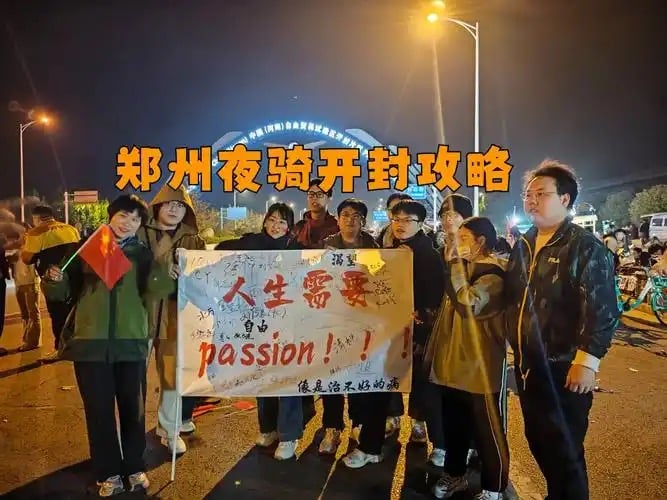
Night riders posing with a poster saying : You need passion in your life (source).
The trend was supported (or facilitated?) by Kaifeng authorities. On November 3, they set up shared bike stations along Zhengkai Avenue to manage the influx of cyclists. Police provided guidance at the scene and ensured safety throughout the night. Kaifeng’s Tourism Bureau issued a “cycling safety advisory” via its official WeChat account, encouraging visitors to adhere to traffic rules, travel sustainably, avoid peak times, and “enjoy the seasonal beauty of Kaifeng with a positive attitude.”
Starting on November 3, Kaifeng’s main tourist attractions, such as Millennium City Park, Wansui Mountain, and Daxiangguo Temple were specially opened to the ‘night riders’ in the middle of the night, even offering them free annual tourism passes (#开封多个景点为夜骑大学生免费#). At this time, the slogan “Youth is priceless, seize the night ride to Kaifeng” (“青春没有售价,夜骑开封拿下”) was actively promoted at Kaifeng tourist spots and in the media.
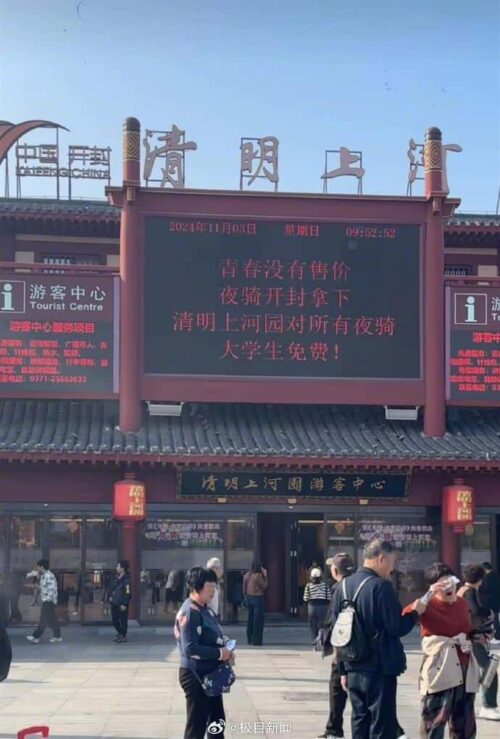
Historical cultural theme park Millennium City Park in Kaifeng on November 3, promoting free access to night riders and the slogan “Youth is priceless, seize the night ride to Kaifeng.”
The shuttle bus taking students back to Zhengzhou was provided for free.
On social apps like Xiaohongshu, students shared various ‘strategy guides’ for the best way to navigate the nightly ride to Kaifeng, including tips such as:
- Choose a comfortable shared bike and avoid unlocking it along the way. With a bike like HelloBike, the journey will only cost 19.5 RMB ($2.70). Starting from Zhengzhou Sports Center Station, head north on Jinshui Road and cycle east in a straight line to Kaifeng. The trip should take about 4 hours.
- From Zhengzhou University to Kaifeng Gulou, the total distance is 79.4 km, with an estimated travel time of 6 hours and 38 minutes. Including breaks and meal stops, the journey could take at least 8 hours.
- Bring a small flag for photo opportunities.
- Upon arrival, visit the Haidilao hotpot restaurant, where they provide blankets and snacks.
- Must-try local dishes: soup dumplings, egg casserole, and deep-fried dough with soy milk.
GOING DOWNHILL
During the weekend of November 8-9, numerous videos emerged showing thousands of students cycling from Zhengzhou to Kaifeng, revealing chaotic scenes (link, link). Some estimates suggested that over 30,000 students had arrived in Kaifeng in a single night.
The trend had a significant impact, raising several concerns. Safety issues loomed large as the sheer number of bicycles on the road created risks, especially given that many participants lacked experience with long-distance cycling. Traffic congestion reached such levels that some cars became trapped amid the cycling groups.

The shared bike system also faced severe challenges. While students eagerly undertook the 4-5 hour downhill journey to Kaifeng, they were unwilling to make the uphill return to Zhengzhou. This resulted in thousands of bikes being abandoned in Kaifeng or along the route, requiring retrieval by the bike companies.
Beyond logistical strain on the bike-sharing system, the abandoned bikes caused significant disruptions in Kaifeng, with entire roads blocked. In Zhengzhou, locals complained about a lack of available bikes for their commutes.

Shared bike chaos in Kaifeng.
While some praised the students’ adventurous spirit, others grew increasingly frustrated with the mounting problems.
By the afternoon of November 9, the official narrative shifted.
Initially, Chinese media celebrated the trend, but reports soon focused on its downsides. One widely shared story featured a 34-year-old man who had joined the ride with his daughter. Unaccustomed to cycling, he became exhausted after only 12-13 kilometers (about 8 miles) (#郑州34岁男子跟风夜骑开封后住院#). He was later hospitalized and diagnosed with hypokalemia (low potassium levels). The message? “Don’t blindly follow the trend.”
Authorities quickly stepped in to stop the night rides. Traffic police in Zhengzhou and Kaifeng issued a joint announcement banning the use of bike lanes on Zhengkai Avenue from 16:00 on November 9 to 12:00 on November 10.
Three major shared bike companies—Meituan, HelloBike, and Qingju—released statements reminding users that their bikes were not intended for cross-city travel. Bikes taken beyond designated zones would automatically lock and incur ‘relocation fees.’
Several universities implemented strict measures, ordering students back to campus and enforcing lockdowns. By Sunday night, some students took to Weibo to report that they were still not allowed to leave their campuses.
THE ROAD AHEAD
Despite the official crackdown on night rides to Kaifeng, some Zhengzhou students have now shifted to walking the entire route, a journey that can take up to 11 hours—equating to 70,000-100,000 steps on a smartwatch pedometer.
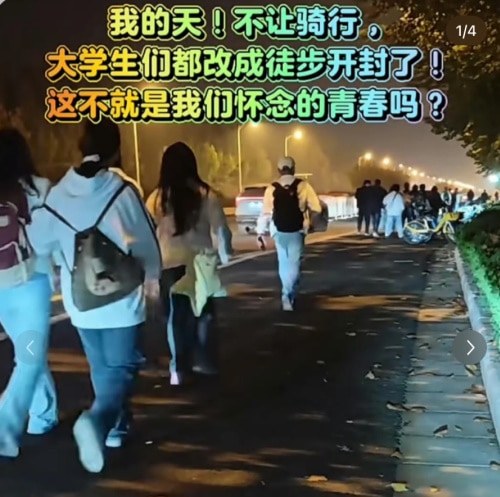
Unable to cycle, groups of students decided to walk to Kaifeng.
The crackdown on the nightly cycling craze has also prompted some reflection.
While many netizens praise the students for “truly embodying youth and vitality,” others see a deeper significance in the trend.
On Weibo, author Xu Kaizhen (许开祯) offers his perspective on what the Kaifeng phenomenon reveals about Chinese youth today. He writes:
“On the surface, the Kaifeng craze appears to be the latest trend in cultural tourism. But at its core, it has nothing to do with tourism. What is it really about? It’s about young people, about youth. And it’s not about youthful rebellion or hormones—modern youth have moved beyond that. It’s about escape. A collective, grand escape. An escape from a mediocre era, a mediocre life, and even a mediocre background. Every young person who joined the night ride was driven by a need to escape. Dissatisfied with reality yet powerless to change it, they turned to this collective unconscious act of performance art.”
Despite the criticism, it seems many hold a soft spot for China’s youth, understanding the challenges they face. As one popular comment puts it: “I dearly love this generation of Chinese youth. Their daytime has been drained by the previous generation, leaving only the night for them to carve out some space to unwind. ‘Escape’ describes it perfectly.”
For now, it seems the Kaifeng trend isn’t over. What began as an innocent, fun-loving initiative has turned into a mass mobilization that raises questions about hyped-up tourism, city marketing, and, most importantly, the boundless energy of China’s new generation. While the phenomenon has left many puzzled, some argue it’s crucial to grasp the youth’s yearning for these kinds of adventures.
As Xu Kaizhen concluded: “Perhaps by understanding this night ride, we can truly understand this generation. No—perhaps we can begin to understand the coming era.”
See our X thread with videos on this trend.
By Manya Koetse, with contributions by Miranda Barnes
(follow on X, LinkedIn, or Instagram)
Spotted a mistake or want to add something? Please let us know in comments below or email us. First-time commenters, please be patient – we will have to manually approve your comment before it appears.
©2024 Whatsonweibo. All rights reserved. Do not reproduce our content without permission – you can contact us at info@whatsonweibo.com.
What’s on Weibo Chapters
Subscribe

“Li Jingjing Was Here”: Chinese Netizens React to Rumors of “Chinese Soldiers” in Russia

How Ne Zha 2’s Shen Gongbao Became Known as the Ultimate “Small-Town Swot”

Beyond the Box Office: What’s Behind Ne Zha 2’s Success?

Ne Zha 2: Making Donghua Great Again

The Unstoppable Success of Ne Zha 2: Breaking Global Records and Sparking Debate on Chinese Social Media

Our Picks: Top 10 Chinese Buzzwords and Phrases of 2024 Explained

“Dear Li Hua”: The TikTok/Xiaohongshu Honeymoon Explained

Why Chinese Hit Movie “Her Story” is ‘Good Stuff’: Stirring Controversy and Celebrating Female Perspectives

Chiung Yao’s Suicide Farewell Letter: An English Translation

Breaking the Taboo: China’s Sanitary Pad Controversy Sparks Demand for Change

12-Year-Old Girl from Shandong Gets Infected with HPV: Viral Case Exposes Failures in Protecting Minors

Weibo Watch: Christmas in China Is Everywhere and Nowhere

Weibo Watch: A New Chapter

Weibo Watch: China’s Online Feminism Is Everywhere

Story of Chinese Female MA Graduate Going Missing for 13 Years Sparks Online Storm
Get in touch
Would you like to become a contributor, or do you have any tips or suggestions? Get in touch here!
Popular Reads
-

 China Insight10 months ago
China Insight10 months agoThe Tragic Story of “Fat Cat”: How a Chinese Gamer’s Suicide Went Viral
-

 China Music11 months ago
China Music11 months agoThe Chinese Viral TikTok Song Explained (No, It’s Not About Samsung)
-

 China Insight12 months ago
China Insight12 months agoThe ‘Two Sessions’ Suggestions: Six Proposals Raising Online Discussions
-

 China Digital9 months ago
China Digital9 months agoChina’s 2024 Gaokao Triggers Online Discussions on AI





